Uyghur Human and Cultural Rights: 2021 year-end summary
“The ultimate goal [of religious work] is to achieve its complete internal and external sinicisation.” Zhang Xunmou Director, Religious Research Centre, CCP United Front Work Department, 27 August 2019[1]
“They don’t have human rights. It’s not about violating, they just don’t have human rights.” Communist party official in a Frontline interview, transcript, April 7, 2020, PBS.org[2]
The continuing destruction of Uyghur cultural heritage is a key part of China’s policy of eradicating Uyghur identity and traditions. The last seven years of ongoing destruction and damage of cultural monuments continues unabated. An Australian Strategic Policy Institute (ASPI) publication[3] cited by The U.S. State Department’s International Religious Freedom 2020 China-Xinjiang country report[4] estimates that “approximately 16,000 mosques in the region (65 percent of the total) had been destroyed, damaged, or desecrated, and a further 30 percent of important Islamic sacred sites had been demolished.” According to the ASPI report, “The Chinese government’s destruction of cultural heritage aims to erase, replace and rewrite what it means to be Uyghur.”

World famous Uyghur anthropologist Rahile Dawut, working in Xinjiang in 2005, present whereabouts unknown, presumably in detention, Photo credit Lisa Ross.
The State Department’s Office of International Religious Freedom also reported in May 2021 that the whereabouts of “hundreds of prominent Uyghur intellectuals, religious scholars, cultural figures, doctors, journalists, artists, academics, and other professionals… remained unknown.” The same report quotes CCP General Secretary Xi Jinping, stating that the government’s actions to Sinicize Islam were “totally correct and must carry on for a long time.”
The primary tools available to countries that want to influence human rights policy in China are economic ones. The US’s choice, as a major market nation for China, was to use both direct import restrictions on goods and export bans on sensitive technology. In addition, indirect pressure might be brought to bear on Chinese suppliers using forced labor by US companies dependent upon Chinese raw materials, parts and finished goods. The goal of US legislation in 2021 was not to halt imports but to stop products made by slave labor from entering the US. This could not be done simply by banning goods made in the Xinjiang Uyghur Autonomous Region (XUAR), since the Chinese government is now promoting forced labor by Uyghurs and moving former detainees to factories far outside Xinjiang’s borders. Equally clearly, China was not motivated to ensure free and humanitarian working conditions for people it viewed as both inferior and threatening.
Uyghur Forced Labor Prevention Act signed into law.
The Uyghur Forced Labor Prevention Act (H.R. 6256) will prevent importation of goods mined, produced, or manufactured wholly or in part with forced labor in Xinjiang, China; it will also apply to goods made by forced labor – essentially slave labor – by other persecuted minorities, including Kazakhs, Kyrgyz, and Tibetans. The bill was passed unanimously by both the US House of Representatives and the Senate on December 14 and 16, 2021 respectively. It was signed into law on December 23rd by President Biden.

Uyghur transfers to other parts of China from 2017 to 2020, Australian Strategic Policy Institute, International Cyber Policy Centre, ‘Uyghurs for Sale’, https://www.aspi.org.au/report/uyghurs-sale
The bill is particularly directed at goods made in China’s Xinjiang Uyghur Autonomous Region (XUAR), where an estimated million persons are being held in concentration camps. Following so-called ‘release’ from detention, at least 100,000 workers, many of whom are young women, are taken from the camps or shipped against their will and compelled to work long hours every day in factories in the XUAR and in other parts of China; they cannot leave the factories or contact their families or children.[5]
A report by the US Labor Department’s Bureau of International Labor Affairs stated that in Kashgar, “Uyghur detainees work as forced laborers to produce textiles. They receive little pay, are not allowed to leave, and have limited or no communication with family members.”[6] The Labor Department report documents how Uyghur workers who are sent without any choice to factories in coastal Quanzhou, Fujian Province work longer hours than Han workers, are forced to live in gated, locked dormitories, and escorted from there to the factory by police from Xinjiang. They cannot leave and police have confiscated their documents.[7]
Brutal conditions in concentration camps, with no respite.
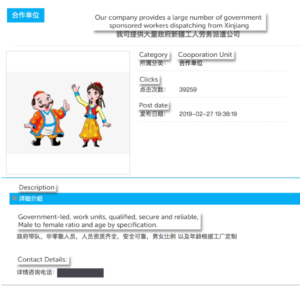
Advertisement to supply government-sponsored Uyghur workers from Xinjiang to other provinces. Australian Strategic Policy Institute, Policy ‘Uyghurs for Sale.’ March 2020.
Congressman Smith of New Jersey, the Republican co-sponsor of the bill and a longtime champion of human rights, spoke at length about the testimony of a Uyghur woman tortured repeatedly with electroshock in the camps. She described how at night, guards were “transferring people between cells and removing the dead bodies would happen all night long. In the silence of the night, we would hear the men from the other cells groaning in agony. We could hear the beatings, the men screaming…”
See Congressional Record Vol. 167, No. 215 (House of Representatives – December 14, 2021)
The Uyghur Forced Labor Prevention Act states that it is the policy of the United States:
1. to actively work to prevent, publicly denounce, and end human trafficking including with respect to forced labor… a modern form of slavery;2. to regard the prevention of atrocities… in the national interest of the United States, including efforts to prevent torture, enforced disappearances, severe deprivation of liberty, including mass internment, arbitrary detention, and widespread and systematic use of forced labor, and persecution targeting any identifiable ethnic or religious group; and3. to address gross violations of human rights in the Xinjiang Uyghur Autonomous Region

Pomegranate Seed Night promoting assimilation and ‘ethnic unity.’ Uyghur workers at forced labor factory. Australian Strategic Policy Institute, Policy ‘Uyghurs for Sale.’ March 2020.
Under the Act, goods made in the XUAR will be presumed to be made wholly or in part by forced labor and cannot be imported. The US Customs and Border Protection Commissioner can make exceptions only if the importer can show that it complied with all guidelines and by providing clear and convincing evidence that the goods were not produced or manufactured, wholly or in part, by forced labor.
The bill will create a Forced Labor Enforcement Task Force decide how best to prevent goods made by forced labor by members of persecuted groups in China from entering the US. It specifically calls for coordination with Mexico and Canada to halt attempts at passing goods across their borders into the United States.
A public comment period and a hearing to take public testimony will follow passage of the Act, with guidelines preventing imports taking effect at the end of June 2022.
Kindergarten ‘investment’ is a cover for forced removal of Uyghur children from families and culture.
China’s expanded kindergarten renovations are a cover for indoctrinating children into exclusively Chinese language and culture – including thousands of children taken from their parents, who have been sent to concentration camps. The $63 million the Chinese government says it has “invested” in preschool education is really intended to eliminate Uyghur language and culture within a generation.
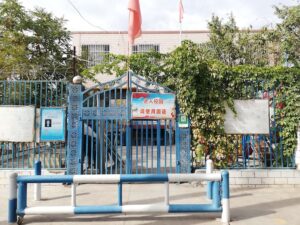
An entrance to a school in Turpan, Xinjiang, China. The sign on the entrance says “Entrance to the school grounds. Please speak ‘Guoyu’ i.e. Mandarin Chinese).” Author Kubilayaxun, 19 August 2018, CCA-SA 4.0 International license.
The Uyghur Tribunal in London (an independent people’s tribunal investigating genocide in the XUAR) ruled December 9, 2021 that China’s policies on its Muslim population in Xinjiang were genocidal and crimes against humanity – and that these polices extend even to small children:
“Children as young as a few months were separated from their families and placed in orphanages or state-run boarding schools. In some cases the parents of these children did not know if their children were alive or dead,” it said.
“The use of the Uyghur language has been punished. Children from an early age have been denied education in their native language and have been punished for the use of it.”
Although bilingual education is guaranteed in China’s constitution for its ethnic minorities, in Tibet, Mongolia, and among southern Chinese minority groups, President Xi’s policies have made pre-school and elementary education entirely in Chinese. Even children’s television and cartoons in parts of China where other languages were dominant, are now exclusively in Mandarin Chinese.
Another government program, called Pomegranate Flower, was instituted in the fall to “pair up” children as young as infants and toddlers with Han Chinese families across the country. The program’s official goal is to encourage people to “hug each other tightly like pomegranate seeds” to build a Chinese national identity that goes beyond ethnicity. Children are assigned Chinese “families” who will call and visit them in the XUAR. There was no explanation given why children needed this family interaction – Uyghur analyst Ilshat Hassan told Radio Free Asia that in reality, their parents had either been detained in internment camps or sent elsewhere in China to perform forced labor.
Leaked government documents show UK illegally imported cotton produced by prisoners in camps.
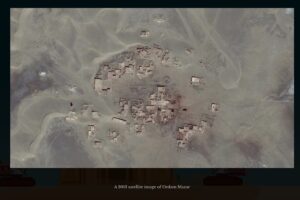
2013 satellite image of ancient shrine Ordam Mazar, Nathan Ruser , Dr James Leibold , Kelsey Munro & Tilla Hoja, Cultural erasure, ASPI, 24 September 2020, https://www.aspi.org.au/report/cultural-erasure
Earlier this year, the UK Parliament voted unanimously to declare that China’s government was committing genocide and crimes against humanity in Xinjiang. On December 15, 2021, England’s High Court allowed a case to go forward against UK authorities for allowing cotton imports from slave labor. Evidence from the World Uyghur Congress (WUC) and UK nonprofit Global Legal Action Network (GLAN) including firsthand witness statements, a secret memo from within the textile industry and leaked government documents all supported their case that importers were violating the Proceeds of Crime Act, the UK’s chief anti-money laundering, organized crime legislation.
England has prohibited imports of goods made by slave labor since the 19th century. China claims that the camps are ‘vocational training centers,’ but they are in fact concentration camps where between 1-3 million Uyghur minority men, women and teenagers have been held for indefinite periods and subjected to horrendous abuse including torture, rape, and brain-washing. Hundreds of factories have been built adjacent to the camps and inmates are forced to work there long hours.
A successful case brought under the Proceeds of Crime Act could result in seizure of funds from companies selling illegal goods and could stop UK companies from further trading in slave-made goods. The UK Parliament said on July 8 that the government should consider banning cotton goods made in Xinjiang altogether – even publishing a Uyghur language version of its report condemning the Chinese government’s human rights abuses. The Parliamentary policy paper sought legal action to keep businesses from incorporating slave-made goods into their supply chains.
Unprecedented US Holocaust Memorial Museum report on China’s genocide.

Complete destruction of Ordam Mazar, Cultural erasure, ASPI, 24 September 2020, https://www.aspi.org.au/report/cultural-erasure
The United States Holocaust Memorial Museum (USHMM) issued an unprecedented public report entitled, “To Make Us Slowly Disappear,”[8] in November 2021. The report focused on crimes against humanity perpetrated against the Uyghur population in China. Among these crimes, it identified “forced sterilization, sexual violence, enslavement, torture, forcible transfer, persecution, and imprisonment.”[9] The report was undoubtedly influential in spurring Congress and the President to act to block import of Chinese goods made by slave labor under the Uyghur Forced Labor Prevention Act.
The USHMM’s Simon-Skjodt Center for the Prevention of Genocide “seeks to do for victims of genocide today what was not done for the Jews of Europe.” The organization believes that the Holocaust was preventable, and that future genocides can be prevented with bipartisan commitment among policy makers to prevent and respond to genocide and crimes against humanity. To that purpose the Center engages in “extensive research and analysis, education, and public and governmental outreach.”
The USHMM report states its “grave concern that the Chinese government may be committing genocide against the Uyghurs.” After decades of following a policy of educational, economic, and social pressure to forcibly assimilate Uyghurs into Han Chinese culture, China’s government has aggressively moved to shrink the Uyghur population in total. The government is using sterilization and forced late-term abortions both in the camps and public ‘health’ programs to eliminate births. It has separated the sexes through incarceration and forcible transfer to prison-like factories.
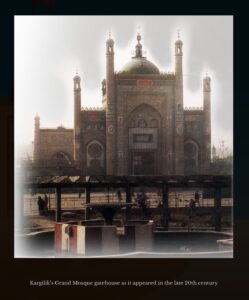
Kargalik Grand Mosque Gatehouse late 20th C, ‘Cultural erasure,’ ASPI, 24 September 2020, https://www.aspi.org.au/report/cultural-erasure
There are approximately 12 million Uyghurs and Kazakh Muslims in Xinjiang; they form only half of the total population after decades of extensive government-encouraged Han Chinese immigration. Between 1 and 3 million Uyghurs have been detained in camps for arbitrary time periods simply because of their ethnic identity and religion.[10]
The USHMM report notes that, “Uyghurs are being detained—due to non-criminal expressions of their culture and religion, such as “having religious marriage rites,” or “donating to a mosque”—and are targeted “based on their ethno-religious practices.”[11] (Actions rendering persons subject to arbitrary detention have included, for women, having formerly worn a veil,[12] or for men, having formerly had a long beard, or giving their children Muslim names.[13]) Uyghurs are often sent to camps based solely on having a family member who was separately detained or for communicating with or having a family member outside of China. Many of the reasons for detention are described in a highly organized document known as the ‘Karakax List’, which details the workings of a “system of targeted cultural genocide.” [14]
The USHMM report “To Make us Slowly Disappear” describes the construction of a vast system of camps in the XUAR:
“Between 2017 and 2019, the Chinese government built and expanded hundreds of detention centers and prisons in Xinjiang, and detainee populations soared.[15] While their exact numbers cannot be confirmed, as of August 2020, publicly available data suggests that there are as many as 300 to 400 detention centers and prisons where Uyghurs are being detained.”[16]

Kargalik Grand Mosque Gatehouse, September 2018, ‘Cultural erasure,’ ASPI, 24 September 2020,Under the Chinese government’s “four entrances” campaign, mosques across Xinjiang are required to hang the national flag, post copies of the Chinese constitution, laws and regulations, uphold core socialist values, and reflect “excellent traditional Chinese culture.”
Architecturally, this involves the removal of Arabic calligraphy, minarets, domes, star and crescent and other symbols deemed “foreign,” and their replacement with government-sanctioned traditional Chinese architectural elements.
The Chinese government frequently refers publicly to the camps as education centers to counter a supposed threat of Muslin terrorism, but having a non-Han identity is sufficient to make someone into a “threat.” Government surveillance and persecution is directed against every person of Uyghur ethnic or Muslim identity. The report describes the Chinese government’s aim of elimination of Uyghur culture through prohibition of Islamic religious practice and Uyghur social and cultural expression, even to the point of denying their ethnic and religious existence:
“In a white paper published in July 2019 by China’s State Council Information Office, the government denied the Uyghurs’ Turkic ancestry, stating that ‘Islam is neither an indigenous nor sole belief system of the Uyghurs’ but was imposed by the expansion of the Arab Empire, and that ‘theocracy’ and ‘religious supremacism’ were a betrayal that needed to be opposed.”[17]
Xinjiang is – or was – home to thousands of ancient and antique shrines and mosques. The USHMM report states that religious buildings are being destroyed wholesale and cemeteries razed:
“Around 8,500 mosques across Xinjiang, constituting approximately one third of the region’s mosques, have been destroyed since 2017.[18] Another 30 percent were “damaged in some way, including the removal of architectural features such as minarets or domes.”[19] About 50 percent of protected cultural sites have been damaged or destroyed, including the total destruction of Ordam mazar (shrine), an ancient site of pilgrimage dating back to the tenth century. Satellite imagery suggests that the majority of sites remained as vacant lots while others were turned into roads and car parks or converted for agricultural use.”[20]
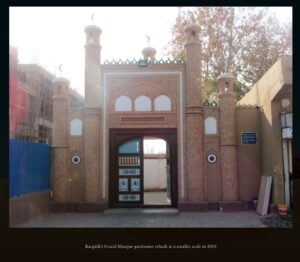
Kargalik Grand Mosque Gatehouse, rebuilt at tiny scale, 2019, ‘Cultural erasure,’ ASPI, 24 September 2020, https://www.aspi.org.au/report/cultural-erasure
The Holocaust Memorial Museum report states that government policies were deliberately focused on reducing or eliminating Uyghur births:[21]
“In 2019, the Chinese government set in motion its Special Action Plan of the ‘Two Thorough Investigations’ of Illegal Births,” mandating counties to implement intrusive birth control measures, notably IUD placements and permanent sterilizations.[22] In the same year, the Xinjiang provincial government planned to either sterilize or place IUDs in at least 80 percent of women of child-bearing age in four prefectures where the Uyghur population is most concentrated.”[23]
Children are forcibly taken from parents and indoctrinated to replace their Uyghur customs, social relationships and language with Chinese language and Han customs. China banned the use of Uyghur and Kazakh textbooks in Xinjiang Schools in 2017.[24] The government has moved far more aggressively to stop children from learning Uyghur culture in since 2018.
Children are forcibly taken from parents and indoctrinated to replace their Uyghur customs, social relationships and language with Chinese language and Han customs. Children as young as toddlers – 14 months old – whose parents are detained or in prison or factories are denied guardianships by grandparent. They are deemed a “special needs category” to be put in “centralized care.”[25] Children at these schools are very poorly supplied, locked in, and relatives cannot visit.[26] The European Parliament has also confirmed that large numbers of Uyghur children are being taken from families. The USHMM resport estimated 880,000 Uyghur children were in boarding facilities in 2020.[27] The US State Department confirmed this estimate of “almost 900,000 children.”[28]
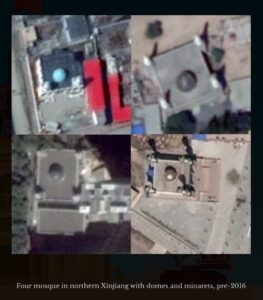
Four mosques with minarets and domes, pre-2016, ‘Cultural erasure,’ ASPI, 24 September 2020, https://www.aspi.org.au/report/cultural-erasure
The USHMM report also details how young, unmarried Uyghur women are coerced into forced marriages with Han Chinese men.[29] Since 2017, approximately a million Han men have been sent into Uyhgur households as “relatives” to live with and spy on suspect families, especially households where the male members have been interned. [30] Traditional Uyghur social relationships are being destroyed by the policy of encouraging Han men to sleep in the same bed with wives of detainees. It is understood that sexual abuse cannot be refused or reported and Uyghurs in exile have described rampant rape and sexual abuse by the “relatives” of even minor girls.[31]
Young women are also strongly pressured to marry these newly arrived Han men – if they refuse, they or their families may be sent to the internment camps.[32] The Chinese government also actively encourages forced marriages through promotional videos about the joys of marriage with compliant, obedient and beautiful Uyghur girls and by reserving places for children of mixed marriages at better schools and universities.
Recommendations for US action.
Many other reports have been made in recent years confirming the SHMM conclusions. One of the most important of these is the Judgment of the Uyghur Tribunal, Summary Form, issued on December 9, 2021, and cited by members of Congress in their remarks for the record on the 2021 Uyghur Forced Labor Prevention Act.
The USHMM report recommends:
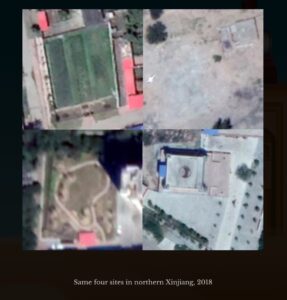
The same four mosques in 2018, ‘Cultural erasure,’ 24 September 2020, ASPI, The United Nations Educational, Scientific and Cultural Organization and International Council on Monuments and Sites have remained silent in the face of mounting evidence of cultural destruction in Xinjiang.
Under their charters, UNESCO and ICOMOS should immediately investigate the state of indigenous, non-Han cultural heritage in Xinjiang and sanction the Chinese government for its abuses. Neither has done so.
(1) “degrading the capacity of perpetrators to commit further atrocities” by “financial sanctions targeting commercial entities that are supporting China’s repressive policies, export controls on advanced technologies, and creation of targeted technologies to jam or disable the technology being used to facilitate atrocities,”
(2) “restrictions on Chinese imports to the United States to exact costs on the Chinese economy,” and “publicity, financial sanctions, and visa bans against Chinese government leaders,” and to
(3) “expedite refugee protections for Uyghurs who have fled China” by passage of the Uyghur Human Rights Protection Act and similar legislation and encouraging other governments to extend protections to Uyghurs residing in or seeking refuge in their countries.
The report details additional steps that could be taken by National Intelligence and the Department of State to raise the visibility of China’s crimes against humanity with other nations and publicly demonstrate solidarity with Uyghur refugees by including them in hearings and discussions. The future of the Uyghur people depends on whether the international community can and will act to prevent their genocide by the Chinese government.
[1] Australian Strategic Policy Institute (ASPI), Xinjiang Data Project, Cultural Erasure, Tracing the destruction of Uyghur and Islamic spaces in Xinjiang, September 24, 2020, https://www.aspi.org.au/report/cultural-erasure, see also https://xjdp.aspi.org.au/explainers/cultural-erasure/
[2] Frontline interview, transcript, April 7, 2020, Episode 18, PBS.org, https://www.pbs.org/wgbh/frontline/film/china-undercover/, video at 34:34.
[3] Australian Strategic Policy Institute (ASPI), Cultural destruction and detention facilities in Xinjiang,
https://www.aspi.org.au/news/cultural-destruction-and-detention-facilities-xinjiang, and also Kelsey Munro, Xinjiang Data Project website launch, September 25, 2020, https://www.aspi.org.au/news/xinjiang-data-project-website-launch.
[4] 2020 Report on International Religious Freedom: China-Xinjiang, United States Department of State, Office of International Religious Freedom, May 12, 2021, https://www.state.gov/reports/2020-report-on-international-religious-freedom/china/xinjiang/
[5] Vicky Xiuzhong Xu, Danielle Cave, Dr. James Leibold, Kelsey Munro, Nathan Ruser, “Uyghurs for Sale, re-education, forced labour and surveillance beyond Xinjiang, Policy Brief, Report No. 26/2020, Australian Strategic Policy Institute (ASPI), March 1, 2020, https://www.aspi.org.au/report/uyghurs-sale. “Under conditions that strongly suggest forced labour, Uyghurs are working in factories that are in the supply chains of at least 82 well-known global brands in the technology, clothing and automotive sectors, including Apple, BMW, Gap, Huawei, Nike, Samsung, Sony and Volkswagen. This report estimates that more than 80,000 Uyghurs were transferred out of Xinjiang to work in factories across China between 2017 and 2019, and some of them were sent directly from detention camps. The estimated figure is conservative and the actual figure is likely to be far higher. In factories far away from home, they typically live in segregated dormitories, undergo organised Mandarin and ideological training outside working hours, are subject to constant surveillance, and are forbidden from participating in religious observances. Numerous sources, including government documents, show that transferred workers are assigned minders and have limited freedom of movement.”
[6] US Department of Labor, Against Their Will: The Situation in Xinjiang, Washington, DC: Bureau of International Labor Affairs, 2020, https://www.dol.gov/agencies/ilab/against-their-will-the-situation-in-xinjiang
[7] Id. Further, in the same Department of labor report, “Victim testimonies, news media, and think tanks report that factories, including for gloves, frequently engage in coercive recruitment; limit workers’ freedom of movement and communication; and subject workers to constant surveillance, retribution for religious beliefs, exclusion from community and social life, and isolation. Further, reports indicate little pay, mandatory Mandarin lessons, ideological indoctrination, and poor living conditions. In some instances, workers have been reported to be subject to torture. More broadly, according to varied estimates, at least 100,000 to hundreds of thousands of Uyghurs, ethnic Kazakhs, and other Muslim minorities are being subjected to forced labor in China following detention in re-education camps.”
[8] To Make Us Slowly Disappear, United States Holocaust Memorial Museum, Simon-Skjodt Center for the Prevention of Genocide, November 2021, https://www.ushmm.org/m/pdfs/November_2021_Uyghur_Report.pdf.
[9] Id. at 2.
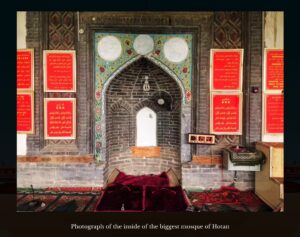
Interior of the largest mosque in Hotan, ‘Cultural erasure,’ ASPI, 24 September 2020, https://www.aspi.org.au/report/cultural-erasure
[10] Id. at 21, See also fn. 95, “US Department of Defense, Assistant Secretary of Defense for Indo-Pacific Security Affairs Schriver Press Briefing on the 2019 Report on Military and Security Developments in China. Several months earlier, State Department Deputy Assistant Secretary for Democracy, Human Rights and Labor Scott Busby referenced “at least 800,000, and possibly more than 2 million” people who had been detained since April
2017. Testimony of Deputy Assistant Secretary Scott Busby, Before the Subcommittee on East Asia, The Pacific, And International Cybersecurity Policy, 115th Congress, 1–7 (2018) (Scott Busby, Dept. Asst. Secretary, Bureau of Democracy, Human Rights and Labor), https://www.foreign.senate.gov/imo/media/doc/120418_Busby_Testimony.pdf. There are no indications that the detention figures have decreased since those statements were made.”
[11] Holocaust Memorial Museum, “To Make Us Slowly Disappear,” p22, quoting Adrian Zenz, The Karakax List: Dissecting the Anatomy of Beijing’s Internment Drive in Xinjiang, Journal of Political Risk, Vol. 8, No. 2, February 2020, section 4.2.4.
[12] Shohret Hoshur, “Uyghur Woman Handed 10-Year Prison Term Over Headscarf Claim,” trans. Richard
Finney, Radio Free Asia, September 19, 2019,
https://www.rfa.org/english/news/uyghur/headscarf-09192017174307.html.
[13] “China Bans Many Muslim Baby Names in Xinjiang: Absurd Edict Part of Growing Restrictions on Uyghurs,” Human Rights Watch, April 24, 2017,
https://www.hrw.org/news/2017/04/25/china-bans-many-muslim-baby-names-xinjiang;
[14] Adrian Zenz, The Karakax List: Dissecting the Anatomy of Beijing’s Internment Drive in Xinjiang, Journal of Political Risk, Vol. 8, No. 2, February 2020, https://www.jpolrisk.com/karakax/. The “Karakax List” is a leaked government document named after the county of Karakax (Qaraqash) in Hotan Prefecture. Zenz states that the Karakax List “lays bare the ideological and administrative micromechanics of a system of targeted cultural genocide that arguably rivals any similar attempt in the history of humanity. Driven by a deeply religio-phobic worldview, Beijing has embarked on a project that, ideologically, isn’t far from a medieval witch-hunt, yet is being executed with administrative perfectionism and iron discipline.”
[15] Id. at 21, See also fn. 93 “[Adrian] Zenz, “Wash Brains, Cleanse Hearts”; “Exploring Xinjiang’s Detention System,” Australian Strategic Policy Institute.; Shaun Tandon, “Uighur researchers say China running more camps than known,” Agence France-Presse, November 12, 2019,
https://news.yahoo.com/uighur-researchers-china-running-hundreds-more-camps-181157759.html.”
[16] Id. at 21, see also fn. 94: Alison Killing, Megha Rajagopalan, and Christo Buschek, “Blanked-Out Spots On China’s Maps Helped Us Uncover Xinjiang’s Camps,” Buzzfeed News, August 27, 2020,
https://www.buzzfeednews.com/article/alison_killing/satellite-images-investigation-xinjiang-detention-camps; Kelsey Munro, “Xinjiang Data Project website launch,” Australian Strategic Policy Institute, September 25, 2020, https://www.aspi.org.au/news/xinjiang-data-project-website-launch.
[17] Id. at 19, see also fn. 83: “The State Council Information Office of the People’s Republic of China, Historical Matters Concerning Xinjiang: VII. Islam Is Neither an Indigenous nor the Sole Belief System of the Uygurs, July 2019. Online, http://www.scio.gov.cn/ztk/dtzt/39912/41087/41103/Document/1660045/1660045.htm; Ben Westcott and Yong Xiong, “Xinjiang’s Uyghurs didn’t choose to be Muslim, new Chinese report says,” CNN, July 22, 2019, https://edition.cnn.com/2019/07/22/asia/china-xinjiang-uyghur-muslim-intl-hnk/index.html; “Break Their Lineage,” Human Rights Watch.
[18] Id. at 20, See also fn. 90: “Chris Buckley and Austin Ramzy, “China Is Erasing Mosques and Precious Shrines in Xinjiang,” New York Times, September 25, 2020, https://www.nytimes.com/interactive/2020/09/25/world/asia/xinjiang-china-religious-site.html.
[19] Id. at 20, see also fn. 91: “Helen Davidson, “Thousands of Xinjiang mosques destroyed or damaged, report finds,” The Guardian, September 25, 2020,
https://www.theguardian.com/world/2020/sep/25/thousands-of-xinjiang-mosques-destroyed-damaged-china-report-finds.”
[20] Id. at 20, see also fn. 92: ““Xinjiang govt denies foreign media reports of ‘tearing down mosques,’ says it is reconstructing them for safety of Muslims,” Global Times, April 19, 2021, https://www.globaltimes.cn/page/202104/1221463.shtml.”
[21] Id. at 10, see also fn. 4, Adrian Zenz, “Sterilizations, IUDs, and Mandatory Birth Control: The CCP’s Campaign to Suppress Uyghur Birth Rates in Xinjiang,” Jamestown Foundation, March 17, 2021, 3, https://jamestown.org/product/sterilizations-iuds-and-mandatory-birth-control-the-ccps-campaign-to-suppre
ss-uyghur-birthrates-in-xinjiang/.
[22] Id. at 26, See also fn. 121: Zenz, “Sterilizations, IUDs, and Coercive Birth,” sections 2.1.–2.3
[23] Ibid,. 2-3, 12.
[24] Qiao Long and Yang Fan, “China Bans Use of Uyghur, Kazakh Textbooks, Materials in Xinjiang Schools,” Radio Free Asia, October 13, 2017, https://www.rfa.org/english/news/uyghur/ethnic-textbooks-10132017135316.html
[25] In one township, over 400 minors had both parents in some form of internment, and many more a single parent. Many children are reportedly kept in appalling conditions. See Break Their Roots: Evidence of Chine’s Parent-Child Separation Campaign in Xinjiang, Journal of Political Risk, Vol. 7, No. 7, July 2019, https://www.jpolrisk.com/break-their-roots-evidence-for-chinas-parent-child-separation-campaign-in-xinjiang/
[26] Ibid., 1
[27] European Parliament, Resolution on forced labour and the situation of the Uyghurs in the Xinjiang Uyghur Autonomous Region, 2020/2913 (RSP), Strasbourg: Legislative Observatory, 2020. para D, https://oeil.secure.europarl.europa.eu/oeil/popups/ficheprocedure.do?lang=en&reference=2020/2913(RSP)
[28] U.S. State Department’s Office of International Religious Freedom, 2020 Report on International Religious Freedon: China-Xinjiang, Executive Summary, May 12, 2021, https://www.state.gov/reports/2020-report-on-international-religious-freedom/china/xinjiang/.
[29] “To Make Us Slowly Disappear,” p 10, 40.
[30] ‘Male Chinese ‘Relatives” Assigned to Uyghur Homes Co-Sleep with Female ‘Hosts’,” Radio Free Asia, October 31, 2019, https://www.rfa.org/english/news/uyghur/cosleeping-10312019160528.html.
[31] ‘This is mass rape’: Uighur activist condemns program said to pay Chinese men to sleep with Uighur women to promote ‘ethnic unity’, Business Insider, December 24, 2019, https://www.insider.com/uighur-activists-mass-rape-chinese-men-xinjiang-2019-12
[32] Leigh Hartman, China coerces Uyghur women into unwanted marriages, Share America, September 24, 2019, https://share.america.gov/china-coerces-uyghur-women-into-unwanted-marriages/
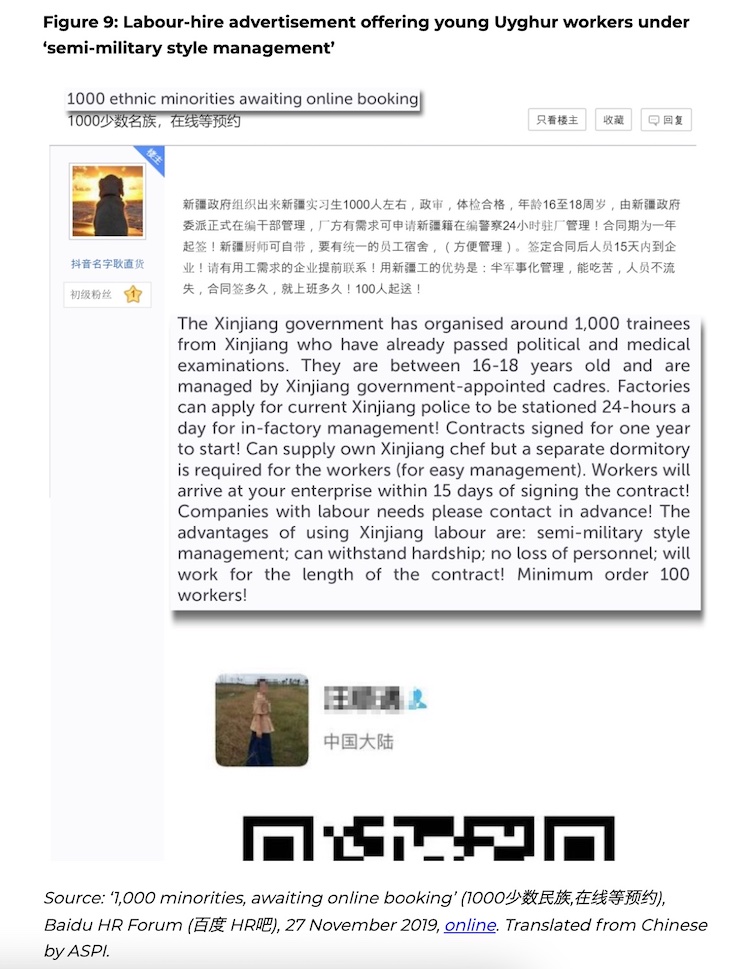 Uyghur Labor Hire advertisement, Nathan Ruser , Dr James Leibold , Kelsey Munro & Tilla Hoja, Australian Strategic Policy Institute (ASPI) publication, 'Cultural erasure,' 24 September 2020, https://www.aspi.org.au/report/cultural-erasure.
Uyghur Labor Hire advertisement, Nathan Ruser , Dr James Leibold , Kelsey Munro & Tilla Hoja, Australian Strategic Policy Institute (ASPI) publication, 'Cultural erasure,' 24 September 2020, https://www.aspi.org.au/report/cultural-erasure. 

